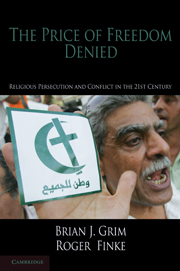Book contents
- Frontmatter
- Contents
- Preface:Religions' Shared Experience of Religious Persecution and Conflict
- 1 Religious Persecution
- 2 Religious Freedom
- 3 Persecution
- 4 Case Studies
- 5 A Closer Look
- 6 What about Muslim-Majority Countries?
- 7 Do Religious Freedoms Really Matter?
- Appendix Testing the Competing Arguments
- Bibliography
- Index
2 - Religious Freedom
Broken Promises
Published online by Cambridge University Press: 05 June 2012
- Frontmatter
- Contents
- Preface:Religions' Shared Experience of Religious Persecution and Conflict
- 1 Religious Persecution
- 2 Religious Freedom
- 3 Persecution
- 4 Case Studies
- 5 A Closer Look
- 6 What about Muslim-Majority Countries?
- 7 Do Religious Freedoms Really Matter?
- Appendix Testing the Competing Arguments
- Bibliography
- Index
Summary
When Abdul Rahman was charged with converting from Islam to Christianity, the apparent contradictions of the Afghan constitution were gradually revealed. The Afghan judge explained that “[w]e are not against any particular religion in the world. But in Afghanistan, this sort of thing is against the law. It is an attack on Islam.” In contrast, representatives from across the globe claimed that the new Afghan constitution promised religious freedom for all. The president, Hamid Karzai, was no doubt painfully aware that supportive evidence could be garnered for both sides. Article 2 of the constitution proclaims that all religions “are free to exercise their faith and perform their religious rites within the limits of the provisions of law” but Article 3 explains that “no law can be contrary to the beliefs and provisions of the sacred religion of Islam.” Afghanistan is not the only country to pronounce religious freedoms with one statement, only to deny them in the next. We find that promises of freedom were frequently denied.
This chapter will try to uncover how and why religious freedoms are denied. First, we review the promise and practice of religious freedom. Using our coding of the International Religious Freedom reports, we document that religious freedoms are consistently promised, yet frequently denied. Next we will attempt to address how: If freedoms are so consistently promised, how are they denied? Here we document how promised freedoms give way to administrative discretion or fall prey to “higher” priorities.
- Type
- Chapter
- Information
- The Price of Freedom DeniedReligious Persecution and Conflict in the Twenty-First Century, pp. 25 - 60Publisher: Cambridge University PressPrint publication year: 2010
- 1
- Cited by



